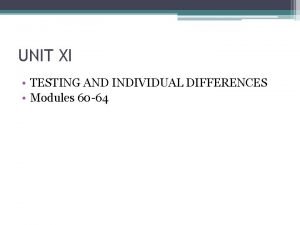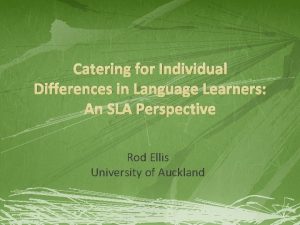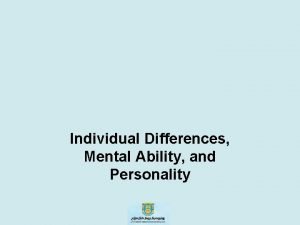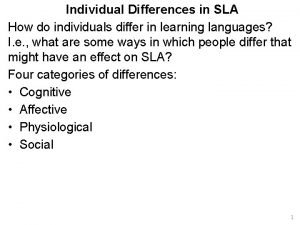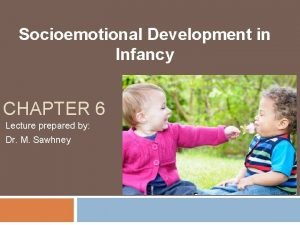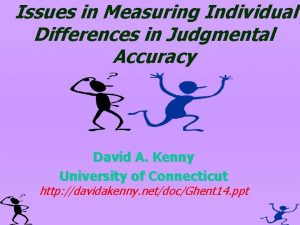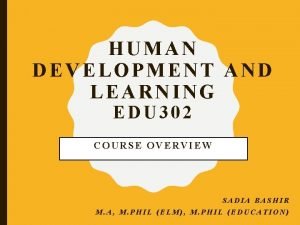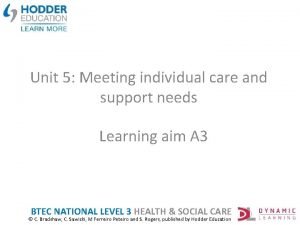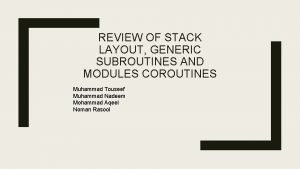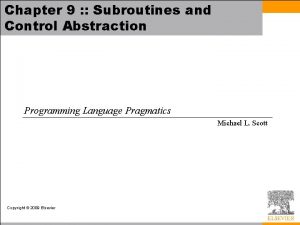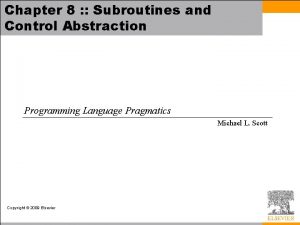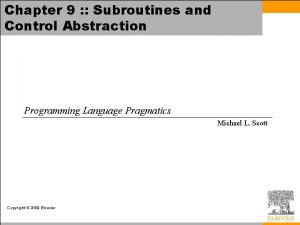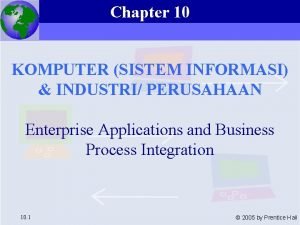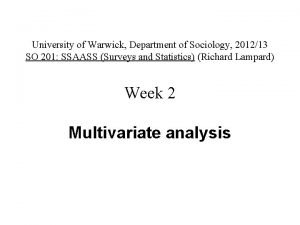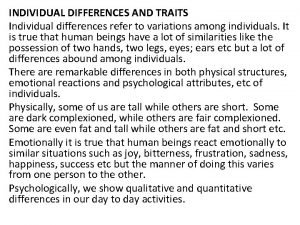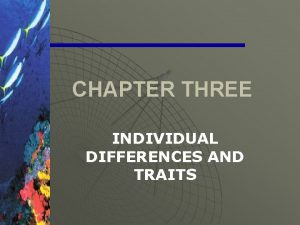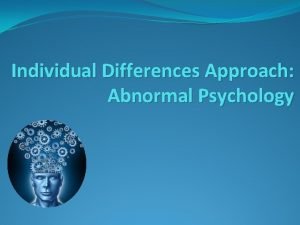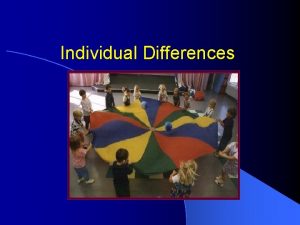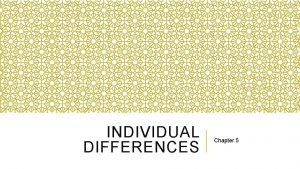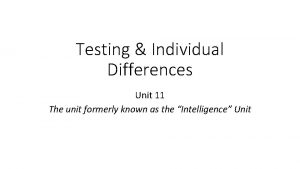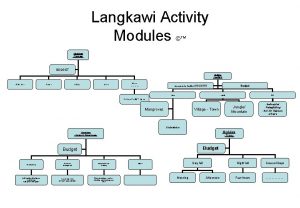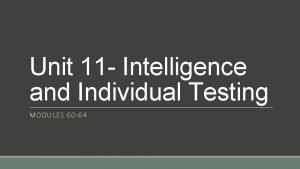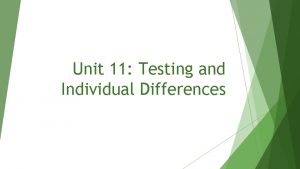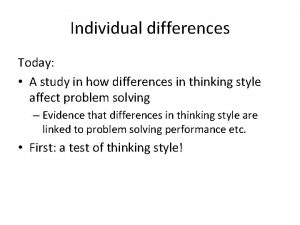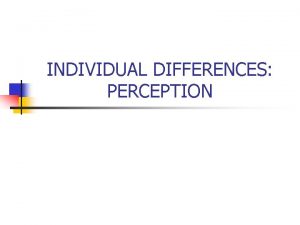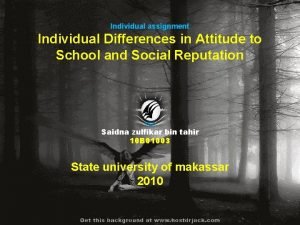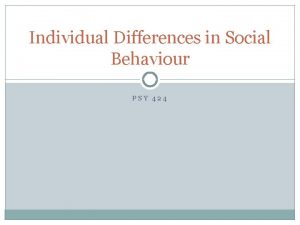UNIT XI TESTING AND INDIVIDUAL DIFFERENCES Modules 60




















































- Slides: 52

UNIT XI • TESTING AND INDIVIDUAL DIFFERENCES • Modules 60 -64

Testing And Individual Differences Intelligence § What Is Intelligence? § Theories of Intelligence § Assessing Intelligence § Genetic and Environmental Influences on Intelligence § Group Differences in Intelligence Test Scores

Intelligence Do we have an inborn general mental capacity (intelligence)? If so, can we quantify this capacity as a meaningful number?

What is Intelligence? Intelligence (in all cultures) is the ability to learn from experience, solve problems, and use our knowledge to adapt to new situations. In research studies, intelligence is whatever the intelligence test measures. This tends to be “school smarts. ” Intelligence tests: assess mental abilities and compares them with others using numerical scores.

Intelligence: Ability or Abilities? Have you ever thought that since people’s mental abilities are so diverse, it may not be justifiable to label those abilities with only one word, intelligence?

General Intelligence The idea that general intelligence (g) exists comes from the work of Charles Spearman (1863 -1945) who helped develop the factor analysis approach in statistics. Athleticism, like intelligence, is many things

General Intelligence Spearman proposed that general intelligence (g) is linked to many clusters that can be analyzed by factor analysis. For example, people who do well on vocabulary examinations do well on paragraph comprehension examinations, a cluster that helps define verbal intelligence. Other factors include a spatial ability factor, or a reasoning ability factor.

Opponents of Spearman • L. L. Thurstone: argued against the g factor. • Gave different tests to people and mathematically identified 7 clusters of primary abilities…did not rank them on a single scale of general aptitude. • However…turns out that those who excelled in one of the 7 clusters tended to do well in the others. • So…is there actually evidence of a g factor? ? ?

Contemporary Intelligence Theories Howard Gardner (1983, 1999) supports the idea that intelligence comes in multiple forms. Gardner notes that brain damage may diminish one type of ability but not others. People with savant syndrome excel in abilities nrelated to general intelligence. https: //www. youtube. com/watch? v=j. Vq. RT_k. COL

Howard Gardner proposes eight types of intelligences and speculates about a ninth one — existential intelligence. Existential intelligence is the ability to think about the question of life, death and existence.

Gardner’s Critics • Using factor analysis, recent research has confirmed a g factor. • It predicts performance on various complex tasks and in various jobs. • However…success is not always so easy. • High intelligence does not always correlate to success. • GRIT: recipe for success combines talent with grit. Those who become successful tend to also be passionate and persistent in their goals.

Robert Sternberg (1985, 1999, 2003) also agrees with Gardner, but suggests three intelligences rather than eight. 1. 2. 3. Analytical Intelligence: Intelligence that is assessed by intelligence tests. Creative Intelligence: Intelligence that makes us adapt to novel situations, generating novel ideas. Practical Intelligence: Intelligence that is required for everyday tasks (e. g. street smarts).

Intelligence and Creativity is the ability to produce ideas that are both novel and valuable. It correlates somewhat with intelligence. 1. 2. 3. 4. 5. Expertise: A well-developed knowledge base. Imaginative Thinking: The ability to see things in novel ways. A Venturesome Personality: A personality that seeks new experiences rather than following the pack. Intrinsic Motivation: A motivation to be creative from within. A Creative Environment: A creative and supportive environment allows creativity to bloom.

Emotional Intelligence (EQ) Emotional intelligence is the ability to perceive, understand, and use emotions (Salovey and others, 2005). The test of emotional intelligence measures overall emotional intelligence and its four components.

Emotional Intelligence: Components Component Perceive emotion Understand emotion Manage emotion Use emotion Description Recognize emotions in faces, music and stories Predict emotions, how they change and blend Express emotions in different situations Utilize emotions to adapt or be creative

Emotional Intelligence: Criticism Gardner and others criticize the idea of emotional intelligence and question whether we stretch this idea of intelligence too far when we apply it to our emotions.

Is Intelligence Neurologically Measurable? Brain Size and Complexity Brain Function • Do people with big brains have big smarts? • MRI scans do reveal a +. 33 correlation between brain size and IQ. • Especially in the frontal and parietal lobes • Ex. Einstein’s brain was 15% larger in the parietal lobe’s lower region—math and spatial reasoning. • Neural processing speed? • Brain scans show that smart people use less energy to solve problems. • Verbal intelligence scores are usually related to speed… • Neurologists are studying speed of perception and speed of neural processing.

Assessing Intelligence: Module 61 Psychologists define intelligence testing as a method for assessing an individual’s mental aptitudes and comparing them with others using numerical scores.

Alfred Binet and his colleague Théodore Simon practiced a more modern form of intelligence testing by developing questions that would predict children’s future progress in the Paris school system.

Lewis Terman In the US, Lewis Terman adapted Binet’s test for American school children and named the test the Stanford-Binet Test. The following is the formula of Intelligence Quotient (IQ), introduced by William Stern:

Modern tests of Mental Abilities: David Wechsler Achievement (measure what you learned) tests vs. Aptitude (predict ability to learn) tests Wechsler developed the Wechsler Adult Intelligence Scale (WAIS) and later the Wechsler Intelligence Scale for Children (WISC), an intelligence test for school-aged children.

WAIS measures overall intelligence and 11 other aspects related to intelligence that are designed to assess clinical and educational problems.

Principles of Test Construction For a psychological test to be acceptable it must fulfill the following three criteria: 1. Standardizati on 2. Reliability 3. Validity

Standardization Standardizing a test involves administering the test to a representative sample of future test takers in order to establish a basis for meaningful comparison.

Normal Curve Standardized tests establish a normal distribution of scores on a tested population in a bell-shaped pattern called the normal curve.

Reliability A test is reliable when it yields consistent results. To establish reliability researchers establish different procedures: 1. 2. Split-half Reliability: Dividing the test into two equal halves and assessing how consistent the scores are. Test-Retest Reliability: Using the same test on two occasions to measure consistency.

Validity Reliability of a test does not ensure validity. Validity of a test refers to what the test is supposed to measure or predict. 1. 2. Content Validity: Refers to the extent a test measures a particular behavior or trait. Predictive Validity: Refers to the function of a test in predicting a particular behavior or trait.

MODULE 62: The Dynamics of Intelligence-Aging and Intelligence Cross-sectional Studies Longitudinal Studies • Test at one point in time and compare people of various ages • Consistently found that older adults give fewer correct answers on IQ tests than younger adults. • Retest the same cohort (same group) over a period of years. • Found that until late in life, IQ remains stable. On some tests it even increases. • Why the differences? ?

Raymond Cattell (1963) • Said that general intelligence can be broken down into two relatively independent components called: • Crystallized Intelligence • Fluid Intelligence • **Both types of intelligence are essential to adaptive living.

Crystallized Intelligence • The knowledge a person has acquired, plus the ability to access the knowledge. • **reflects the ability of a person to store and retrieve information from semantic memory. • Measured by tests of vocabulary, arithmetic, and general information.

Fluid Intelligence • The ability to see complex relationships and solve problems. • Abilities that involve using algorithms and heuristics.

IT All DEPENDS: Aging and Intelligence • Crystallized Intelligence • Fluid Intelligence • It depends on what we asses and how we assess it….

Stability over the life span • By age 4, children’s performance on IQ tests begin to predict their adolescent and adult scores. • Consistency increases with age of child. • Scotland study: • More intelligent people live longer…why?

Extremes of Intelligence A valid intelligence test divides two groups of people into two extremes: the intellectually disabled (IQ 70 and below) and individuals with high intelligence (IQ 135 and above). These two groups are significantly different.

Low Extreme: Intellectual disability. • Intellectually disabled (formally known as mentally retarded) individuals required constant supervision a few decades ago, but with a supportive family environment and special education they can now care for themselves. • Must have both a low IQ score and difficulty adapting to the demands of independent living • Intellectual disability is a developmental condition that is apparent before 18 years of age. (Ex. Down Syndrome)

High Extreme: High Intelligence Contrary to popular belief, people with high intelligence test scores tend to be healthy, well adjusted, and unusually successful academically.

Flynn Effect In the past 60 years, intelligence scores have risen steadily by an average of 27 points. This phenomenon is known as the Flynn effect.

Genetic and Environmental Influences on Intelligence: Module 63 No other topic in psychology is so passionately followed as the one that asks the question, “Is intelligence due to genetics or environment? ”

Genetic Influences Studies of twins, family members, and adopted children together support the idea that there is a significant genetic contribution to intelligence.

Adoption Studies Adopted children show a marginal correlation in verbal ability to their adopted parents.

Heritability The variation in intelligence test scores attributable to genetics. We credit heredity with 50% of the variation in intelligence. It pertains only to why people differ from one another, not to the individual.

Environmental Influences Studies of twins and adopted children also show the following: 1. Fraternal twins raised together tend to show similarity in intelligence scores. 2. Identical twins raised apart show slightly less similarity in their intelligence scores.

Early Intervention Effects Early neglect from caregivers leads children to develop a lack of personal control over the environment, and it impoverishes their intelligence. Romanian orphans with minimal human interaction are delayed in their development.

Schooling Effects Schooling is an experience that pays dividends, which is reflected in intelligence scores. Increased schooling correlates with higher intelligence scores. To increase readiness for schoolwork, projects like Head Start facilitate leaning.

Module 64: Group Differences in Intelligence Test Scores Why do groups differ in intelligence? How can we make sense of these differences?

Ethnic Similarities and Differences To discuss this issue we begin with two disturbing but agreed upon facts: 1. Racial groups differ in their average intelligence scores. 2. High-scoring people (and groups) are more likely to attain high levels of education and income.

Racial (Group) Differences If we look at racial differences, white Americans score higher in average intelligence than black Americans (Avery and others, 1994). European New Zealanders score higher than native New Zealanders (Braden, 1994). White-Americans Black-Americans Average IQ = 100 Average IQ = 85 Hispanic Americans

Environmental Effects Differences in intelligence among these groups are largely environmental, as if one environment is more fertile in developing these abilities than the other.

Reasons Why Environment Affects Intelligence 1. 2. 3. 4. 5. 6. Races are remarkably alike genetically. Race is a social category. Asian students outperform North American students on math achievement and aptitude tests. Today’s better prepared populations would outperform populations of the 1930 s on intelligence tests. White and black infants tend to score equally well on tests predicting future intelligence. Different ethnic groups have experienced periods of remarkable achievement in different eras.

Gender Similarities and Differences There are seven ways in which males and females differ in various abilities. 1. Girls are better spellers 2. Girls are verbally fluent and have large vocabularies 3. Girls are better at locating objects 4. Girls are more sensitive to touch, taste, and color 5. Boys outnumber girls in counts of underachievement 6. Boys outperform girls at math problem solving, but under perform at math computation 7. Women detect emotions more easily than men do

The Question of Bias Aptitude tests are necessarily biased in the sense that they are sensitive to performance differences caused by cultural differences. However, aptitude tests are not biased in the sense that they accurately predict performance of one group over the other.

Test-Takers’ Expectations A stereotype threat is a self-confirming concern that one will be evaluated based on a negative stereotype. This phenomenon appears in some instances in intelligence testing among African-Americans and among women of all colors.
 Unit xi testing and individual differences
Unit xi testing and individual differences Managing individual differences and behavior
Managing individual differences and behavior Managing individual differences and behavior
Managing individual differences and behavior Neighborhood integration testing
Neighborhood integration testing Individual differences factors
Individual differences factors Individual differences factors
Individual differences factors Individual differences in workplace
Individual differences in workplace Hukum perbedaan individu adalah
Hukum perbedaan individu adalah Individual differences factors
Individual differences factors Individual differences in sla
Individual differences in sla Principles of training individual differences
Principles of training individual differences Principles of training individual differences
Principles of training individual differences Thomas and chess temperament
Thomas and chess temperament Conclusion of individual differences
Conclusion of individual differences Definition of growth and development
Definition of growth and development Positive negative testing
Positive negative testing Cs 3250
Cs 3250 Meeting individual care and support needs
Meeting individual care and support needs Unit 5 health and social care coursework example p3
Unit 5 health and social care coursework example p3 Unit 5 meeting individual care and support needs
Unit 5 meeting individual care and support needs Unit 6 review questions
Unit 6 review questions Domain test means
Domain test means Motivational overview in software testing
Motivational overview in software testing Data flow testing strategies in software testing
Data flow testing strategies in software testing Localization globalization testing
Localization globalization testing Cause effect graphing technique
Cause effect graphing technique Control structure testing in software engineering
Control structure testing in software engineering Decision table testing in software testing
Decision table testing in software testing Decision table testing in software testing
Decision table testing in software testing Pengertian blackbox testing
Pengertian blackbox testing Behavioral testing adalah
Behavioral testing adalah Table based testing
Table based testing Rigorous testing in software testing
Rigorous testing in software testing Testing blindness in software testing
Testing blindness in software testing Component testing is a black box testing
Component testing is a black box testing Types of domain testing
Types of domain testing What is generic subroutine
What is generic subroutine Erp sales and marketing
Erp sales and marketing Generic subroutines and modules
Generic subroutines and modules Generic subroutines and modules
Generic subroutines and modules Generic subroutines and modules
Generic subroutines and modules All crm packages contain modules for prm and erm.
All crm packages contain modules for prm and erm. Warwick sociology modules
Warwick sociology modules Cisco nexus 5548up price
Cisco nexus 5548up price Who gmp training modules
Who gmp training modules Abs portable accommodation modules
Abs portable accommodation modules Drupal social networking
Drupal social networking Sitecore modules
Sitecore modules Extension in hybris
Extension in hybris Army resilience training slides
Army resilience training slides Psychology ninth edition in modules
Psychology ninth edition in modules Persistent stored modules
Persistent stored modules Modules
Modules
